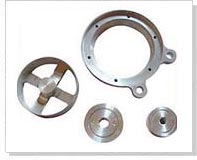
The aluminum industry differentiates and distinguishes one alloy from another by using a standardized numbering system. While wrought aluminum uses a four-digit designation, the cast aluminum uses three-digits. Different prefixes and suffixes are also used in both aluminum classes.
Cast aluminum is obtained after the molten metal is introduced into different shaped molds to get a particular shaped product. The process also includes sand casting, permanent mold casting and die casting. It can also be defined as a metal that is fabricated by allowing it to cool in a mold.
Cast aluminum uses a three digit number with a decimal point. The digit in the hundred's place is the indicator of the alloying elements, while the digit after the decimal point indicates the form ie. whether cast shape or ingot.
Applications of Cast
Aluminum
| Casted Aluminum Alloy
|
Typical
Applications |
| 319.0 |
Manifolds, cylinder heads,
blocks, internal engine parts |
| 332.0 |
Piston |
| 356.0 |
Manifold, Cylinder head |
| A356.0 |
Automotive wheels |
| A380.0 |
Transmission housings/parts,
fuel metering devices, Blocks |
| 383.0 |
Housings, internal engine parts,
steering gears, brackets |
| B390.0 |
Ring gear and internal
transmission parts |
|
|

